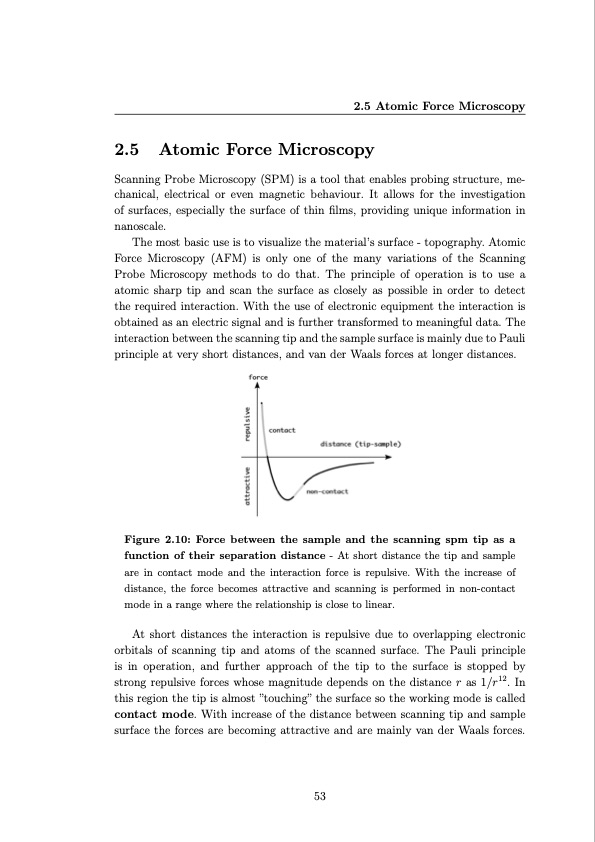
PDF Publication Title:
Text from PDF Page: 074
2.5 Atomic Force Microscopy 2.5 Atomic Force Microscopy Scanning Probe Microscopy (SPM) is a tool that enables probing structure, me- chanical, electrical or even magnetic behaviour. It allows for the investigation of surfaces, especially the surface of thin films, providing unique information in nanoscale. The most basic use is to visualize the material’s surface - topography. Atomic Force Microscopy (AFM) is only one of the many variations of the Scanning Probe Microscopy methods to do that. The principle of operation is to use a atomic sharp tip and scan the surface as closely as possible in order to detect the required interaction. With the use of electronic equipment the interaction is obtained as an electric signal and is further transformed to meaningful data. The interaction between the scanning tip and the sample surface is mainly due to Pauli principle at very short distances, and van der Waals forces at longer distances. Figure 2.10: Force between the sample and the scanning spm tip as a function of their separation distance - At short distance the tip and sample are in contact mode and the interaction force is repulsive. With the increase of distance, the force becomes attractive and scanning is performed in non-contact mode in a range where the relationship is close to linear. At short distances the interaction is repulsive due to overlapping electronic orbitals of scanning tip and atoms of the scanned surface. The Pauli principle is in operation, and further approach of the tip to the surface is stopped by strong repulsive forces whose magnitude depends on the distance r as 1/r12. In this region the tip is almost ”touching” the surface so the working mode is called contact mode. With increase of the distance between scanning tip and sample surface the forces are becoming attractive and are mainly van der Waals forces. 53PDF Image | Investigation of metal-insulator transition in magnetron sputtered samarium nickelate thin films

PDF Search Title:
Investigation of metal-insulator transition in magnetron sputtered samarium nickelate thin filmsOriginal File Name Searched:
Bilewska_Investigation_of_metal_insulator_transition_in_magnetron_sputtered_samarium.pdfDIY PDF Search: Google It | Yahoo | Bing
Sulfur Deposition on Carbon Nanofibers using Supercritical CO2 Sulfur Deposition on Carbon Nanofibers using Supercritical CO2. Gamma sulfur also known as mother of pearl sulfur and nacreous sulfur... More Info
CO2 Organic Rankine Cycle Experimenter Platform The supercritical CO2 phase change system is both a heat pump and organic rankine cycle which can be used for those purposes and as a supercritical extractor for advanced subcritical and supercritical extraction technology. Uses include producing nanoparticles, precious metal CO2 extraction, lithium battery recycling, and other applications... More Info
| CONTACT TEL: 608-238-6001 Email: greg@infinityturbine.com | RSS | AMP |